This section summarises the main events in the development of the Regiment from its foundation up to the time of its amalgamation in 1881. For further information see The Royal Berkshire Regiment by F Loraine Petre, 2 volumes, originally published 1925, reprinted by the Museum in 2004 and available from the online shop.
1743 Raising of the 49th Regiment of Foot

A Marine from the 6th Regiment of Marines in the early 19th century; this Regiment became the 49th Regiment of Foot
On 1 June 1744 an order was given for the amalgamation of the eight independent companies garrisoning Jamaica into a single Regiment. The Army lists 1744-1748 show them as the '49th or 6th Marine Regiment'. The establishment was backdated to 25 December 1743 and was a result of the lobbying of the Governor, Edward Trelawney who, although he had no previous military experience, was appointed Colonel. Due to the time lag in communications between Britain and Jamaica it was not until March 1745 that the order was received and the Regiment was actually formed. It was called Trelawney’s Regiment as it was the fashion at the time to name Regiments after their Colonel. This Regiment was at first numbered 63rd but after the re-organisation of 1748 it became the 49th Regiment of Foot. In 1782 Regiments were given county titles to assist in recruiting. The 49th Regiment then became known as the 49th (Hertfordshire) Regiment.
1777 American War of Independence
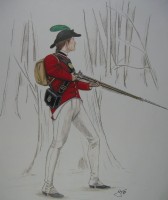
A soldier of the Light Company of 49th Regiment of Foot during the American War of Independence
The Regiment remained in Jamaica until 1764 then moved to Ireland. The American War of Independence brought the Regiment's first major action when it took part in the occupation of Philadelphia in 1777 and the battle at nearby Brandywine Creek. Under cover of a rain storm the 49th's Light Company, who formed part of the 2nd Battalion Light Infantry, made a night attack at nearby Paoli with bayonets. A force of 1500 Americans encamped in a wood were taken completely by surprise, some 300 being killed or wounded with minor loss to the 49th. Humiliated, the Americans accused the British of killing the wounded (a charge proved to be totally unfounded) and vowed to give no quarter to the units involved when they met in later battles. The Light Companies reacted to this threat by dyeing their distinguishing green feathers red so that they should be easily recognised.
This action continued to be commemorated by the wearing of the red Brandywine Flash behind the cap badge by the Royal Berkshire Regiment, the Duke of Edinburgh's Royal Regiment and the Royal Gloucestershire, Berkshire and Wiltshire Regiment.
When the French entered the war in 1778 a force including the 49th was sent to defend the West Indies. Seizing the island of St Lucia a few days before the French arrived, the British managed to defeat a French attack, earning the Regiment its first Battle Honour "St Lucia", although this was not officially sanctioned until 1909.
1801 – 1812 General Sir Isaac Brock
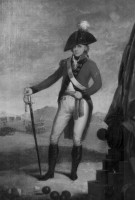
Sir Isaac Brock when he was a Captain, approximately 1792
In 1801 the 49th, under the command of Colonel Isaac Brock, sailed as part of Admiral Parker's fleet (whose second in command was Nelson) to engage the Danish fleet at Copenhagen. In commemoration of its services the Regiment received the Battle Honour 'Copenhagen', and its band was permitted to play Rule Britannia after the Regimental March.
From 1802 to 1814 the 49th served in Canada where it was engaged in frontier warfare with the Americans. One of its finest actions was at Queenstown in October 1812, but this involved the tragic loss of General Sir Isaac Brock.
He had previously commanded the Regiment with great distinction and in 1810 was appointed Commander in Chief in Upper Canada and later Governor of the province. His administration, both civil and military, and the able way in which he established friendly relations with Chief Tecumseh and his Indians meant that long before his death he was recognised as the saviour of Canada.
The place where he died and was later buried is today marked by an impressive monument. The Depot of the Royal Berkshire Regiment, which was created in Reading in 1881, was later named "Brock Barracks" in his memory.
1812 The Battle of Queenstown Heights, Canada
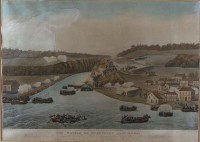
The Battle of Queenstown Heights13 October 1813
The American General Van Renselaar had assembled a force of 6,000men and on 13 October 1812 the invasion of Canada began. Crossing in boats at early dawn the Americans suceeded in gaining a foothold on Queenstown Heights, which was defended by 300 men of the 49th and York Militia with a few heavy guns. General Sir Isaac Brock was at Fort George when he heard the sound of firing and galloped of to Queenstown. He ordered reinforcements from Fort George but, without waiting for their arrival, placed himself at the head of the Light Company of the 49th and advanced to the attack. After one attack had been beaten off he led the second advance and again the Americans opened fire, and Brock conspicuous by his height and uniform, was struck in the right breast by a bullet and fell mortally wounded. He survived but a few minutes. Almost his last words were 'Push on the York Volunteers' alluding to a force of corps now arriving on the scene.
1813 The Battle of Chrysler Farm
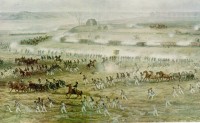
Battle of Chrysler Farm 1813
On 11 November 1813, the British force, which included the 49th, defeated an American force four times its strength. This battle was the turning point of the American War of 1812-14, and made sure Canada remained Independent. Eye witness accounts recorded how the steady platoon volleys, coming in deafening crashes at regular intervals, contrasted with the ragged pop-popping of the American fire. It was the 49th’s last serious action on the war. The regiment was reduced to barely 100 men. Among the casualties was young Ensign Richmond, true to the grim tradition that the officer who bore the 49th Regimental Colour was always hit.
1815 Title "Princess Charlotte of Wales's Regiment"
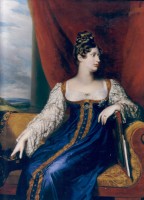
Portrait of Princess Charlotte of Wales
The 49th Regiment returned to England from Canada in 1815 to be stationed at Weymouth. Here they discarded their battered campaign clothing and were issued with new scarlet coats, white breeches, black shakos and gaiters before taking over the duties of guarding those members of the Royal family in residence. So affected was the young Princess Charlotte by the sight of these pipe clayed and polished soldiers that she begged that the 49th might be 'her' Regiment. The request was approved and later that year the title "Princess Charlotte of Wales’s Regiment" was granted.
1840 The Wars in China
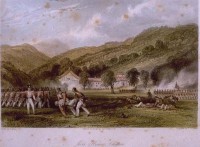
The attack on Joss House, Chapu, showing Colonel Tomlinson being carried from the field of battle, whilst the 49th are advancing with Colours flying.
In 1840 the 49th was sent from India to take part in the "Opium War" with China, spending two years in China fighting in six major battles at Canton, Amoy, Chusan, Chinhae, Chapoo and the Heights of Chin Keang Foo. On 18 May 1842 the 49th took part in a joint atack with the 18th Regiment on Joss House, Chapu, which was defended by a large number of Tartars. The commander, Colonel Tomlinson was killed. Every man who attempted to enter the Joss House was killed or wounded. It was evetually entered and captured after the wall was blown in. The Regiment’s casualties this day were the heaviest of the campaign with two officers and eleven other ranks killed and six officers and forty-five men wounded. In consequence of the distinguished conduct and gallantry displayed by all ranks during the campaign the Regiment was awarded, as a badge, the dragon super-scribed "China". It was the China Dragon that later became the cap badge of the Royal Berkshire Regiment and formed the centre piece of the Regimental badge of the Duke of Edinburgh’s Royal Regiment and the buttons of the Royal Gloucestershire, Berkshire and Wiltshire Regiment.
1854 - 1856 The Crimean War
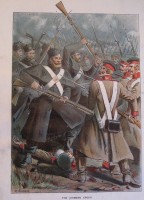
Lieutenant Connolly who was awarded the Victoria Cross during the Crimean War 1854 - 1856
The 49th Regiment was part of the 2nd Brigade, 2nd Division of the British Expeditionary Force, the Brigade being commanded by Lieutenant-Colonel W H Adams of the 49th. Landing on the west coast of the Crimea in September 1854 the 49th took part in the battles of The Alma, Inkerman and the siege of Sevastopol (all three later awarded as battle honours) enduring two harsh Crimean winters.
The actions of Lt J A Conolly, Sgt James Owens and Sgt George Walters during the war eventually led to the award of the Victoria Cross - an honour which had not been instituted at the time of their actions. Their three medals were awarded in 1857.
1860 The Final Years
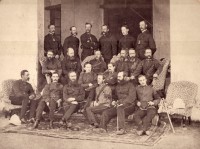
The Officers at Mhow in India in 1872
After service in the West Indies, England, Ireland and India the Regiment was back in England in time for the reorganisation under the Cardwell Scheme which eventually led to its amalgamation with the 66th (Berkshire) Regiment of Foot in 1881.